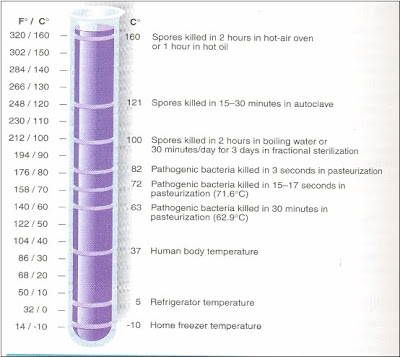Physical Control of Microorganisms: Boiling Water
Introduction and Advantages:
Immersion in boiling water is the first of several moist-heat methods that we shall consider. Moist heat penetrates materials much more rapidly than dry heat because water molecules conduct heat better than air. Lower temperatures and a shorter exposure time are therefore required than for dry heat.
Mode of Action:
Moist heat kills microorganism by denaturing their proteins. Denaturation is a change in the chemical or physical property of a protein. It includes structural alterations due to destruction of the chemical bonds holding proteins in a three-dimensional form. As proteins revert to a two-dimensional structure, they coagulate (denature) and become nonfunctional. Egg protein undergoes a similar transformation when it is boiled. Details in chap 2. The coagulation of proteins requires less energy than oxidation, and, therefore, less heat need be applied.
The effectivenesss of different method according to temperature range and time of sterilization
Conditions for perfect Sterilization:
If it imperative that boiling water be used to destroy microorganisms, materials must be thoroughly cleaned to remove traces of organic matter, such as blood or feces. The minimum exposure period should be 30 minutes, except at high altitudes, where it should be increased to compensate for the lower boiling point of water. All materials should be well covered. Washing soda must be added at a 2 percent concentration to increase the efficiency of the process.
Disadvantages and Microbes Heat Resistance:
Boiling water is not considered a sterilizing agent because the destruction of bacterial spores and the inactivation of viruses cannot always be assured. Under ordinary circumstances, with microorganisms at concentrations of less than 1 million per milliliter, most species of microorganisms can be killed within 10 minutes. Indeed, the process may require only a few seconds. However, fungal spores, protozoan cysts, and large concentrations of hepatitis A viruses require up to 30 minutes exposure while endospores can resist boiling for more than 20 hours. Bacterial spores often require 2 hours or more. The effectiveness of boiling can be increased by adding 2 % sodium bicarbonate to the water. Because inadequate information exists on the heat tolerance of many species of microorganisms, boiling water is not reliable for sterilization purposes. Free-flowing (unpressurized) steam is equivalent in temperature to boiling water.
Uses of Boiling:
The use of boiling to sanitize baby bottles is a familiar example.
